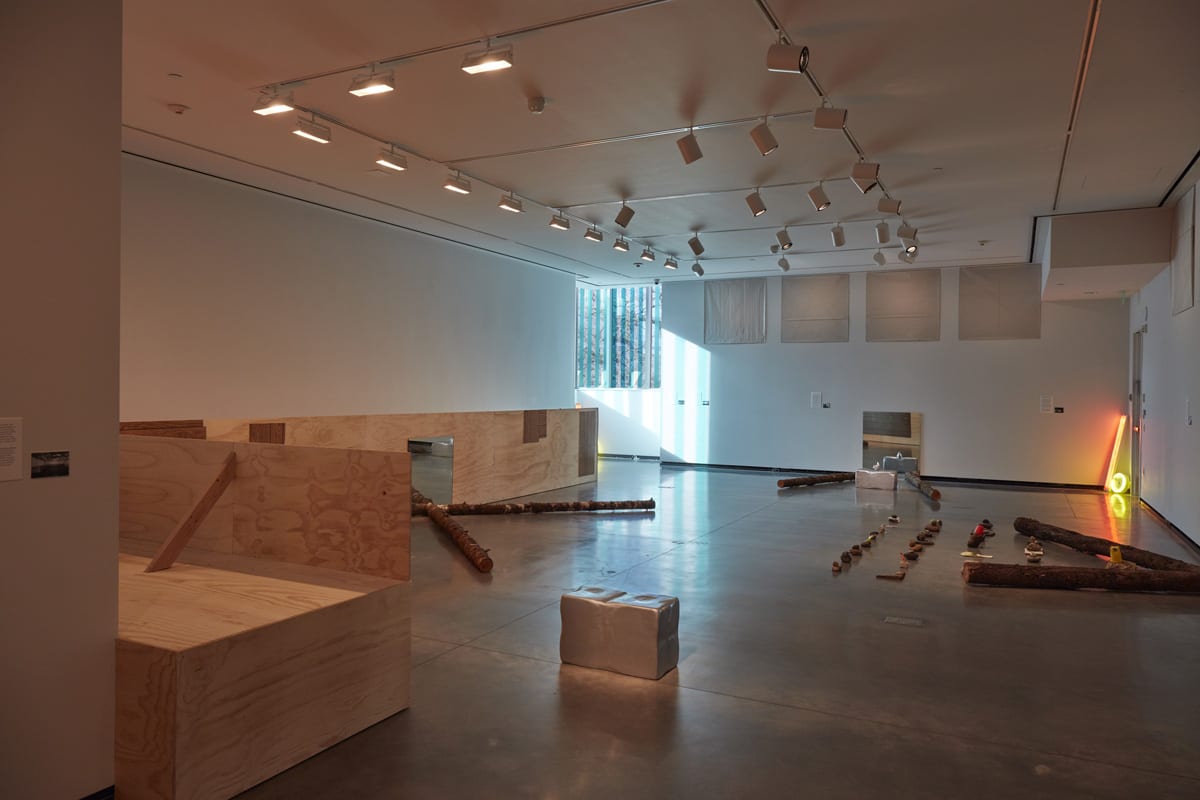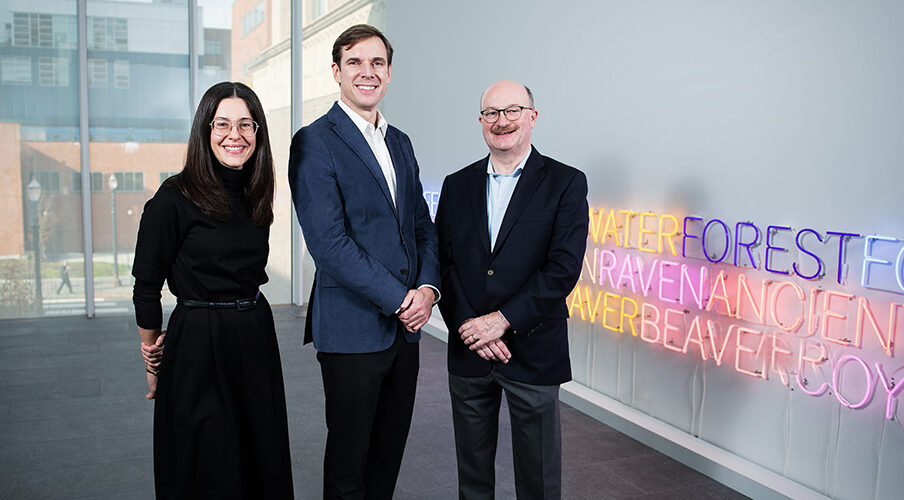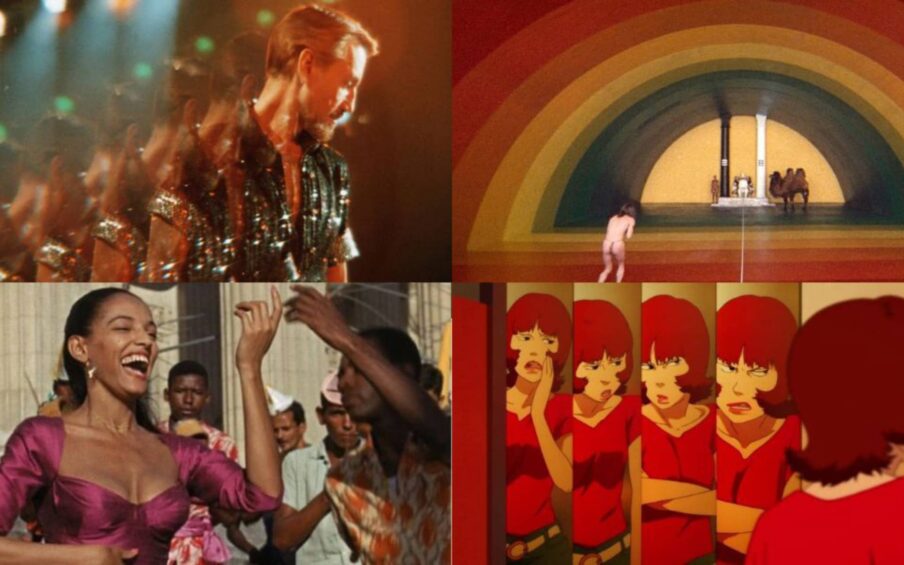The Portland Art Museum is an extensive resource of the art history of the Northwest. Our Crumpacker Library houses several archives, and one of the most sought-after is that of the Portland Center for the Visual Arts, an ambitious contemporary art gallery active from 1972 to 1987. PCVA showcased avant-garde visual and performing artists and occupies a foundational place in Portland’s art community. I was eager to unpack this history and explore PCVA’s connection to the current arts ecosystem with our audiences.
Enter Triple Candie, a duo of art historians—Shelly Bancroft and Peter Nesbett—who transform rigorous archival research into visual and spatial “essays” that upend traditional exhibition models. Artist-run galleries like PCVA were important predecessors for the alternative exhibition space Triple Candie ran in New York City from 2001 to 2010. Now the duo operates as a self-described “phantom curatorial agency” working with museums to create exhibitions about key historical figures or moments, but devoid of art. We connected in 2018 over our mutual fascination with the legendary status of PCVA. The results of our conversations and ruminations is Being Present: Revisiting, Somewhat Unfaithfully, Portland’s Most Experimental Art Experiment, the Portland Center for the Visual Arts, which opened on November 16, 2019, in the Jubitz Center for Modern and Contemporary Art. The exhibition is currently unavailable to view while the Portland Art Museum is closed during the COVID-19 pandemic; once the Museum can reopen, Being Present will remain on extended view into the fall.
Beginning in 2017, I have used the fourth-floor galleries of the Jubitz Center as a space for experimentation by inviting in curators whose practices diverge from conventional museum standards. To help situate our audience members, I posed a few questions to Peter and Shelly about their methods and how they show up in the current exhibition.
—Sara Krajewski, The Robert and Mercedes Eichholz Curator of Modern and Contemporary Art
Sara Krajewski: What excites me about your exhibition is the sense of freedom and play with which you approach art historical research, suggesting that art historians can be creative in the way they approach their subjects and analyses. How did you arrive at this expanded way of working?
Shelly Bancroft: Well, one of the benefits of starting your own organization is that you can define the terms of your work. From the beginning, we have kept things small and nimble so we wouldn’t get too locked into a particular way of working. We were constantly re-assessing what we were doing, why we were doing it, and who it was for. We also had a very small board of directors, which meant we weren’t really accountable to anyone but ourselves.
Peter Nesbett: That said, we did have a breakthrough moment. In 2005, we were working on a few exhibitions that were proving difficult to realize. The artists weren’t available, expected big stipends, or refused to work with us because they didn’t see how it would advance their careers. We were frustrated. So one day we decided to organize two back-to-back guerrilla-style retrospectives, both exhaustively researched. The first was comprised of photocopies; the second, bastardized recreations of an artist’s sculptures. The projects struck a nerve with the press and public, which was good. We realized very quickly that working without artists’ artworks or permissions was tremendously freeing. But it was also scary.
Shelly: Naturally, as art historians, we turned to the past for examples. We looked into the use of plaster casts of Roman and Greek sculpture by 19th-century museums—such as the Pushkin in Moscow, and the short-lived Museum of Copies in Paris. [The Portland Art Museum’s collection was started with a selection of such plaster casts. –SK] We thought about how art museum education departments frequently organize exhibitions using only photographic reproductions. Then, duh, it dawned on us how history museums are full of replicas—furniture, clothing, stagecoaches—all put in the service of the stories they are telling. This gave us courage.
Sara: What does this way of working allow you to do that a book, catalogue essay or traditional exhibition doesn’t?
Shelly: For one, it means we can work on any subject we desire. We can also be a bit more critical than we could be curating a traditional exhibition. With all due respect, most shows we see are either explicitly or implicitly promotional. Their primary purpose seems to be to convince the audience of the subject’s significance. Artists, collectors, and galleries all want the artist’s work presented in the best light. Our projects are not reliant on these sorts of relationships. In fact, we purposely try not to get close to people with a vested interest in the subject we are working on so that we can study it from afar and come to our own conclusions without undue influence. Consequently, we often editorialize in the wall texts and we install the objects as we please—within, of course, the accessibility and safety requirements of the institution.
Peter: As to why we curate exhibitions rather than write books and essays, it is because we recognize the legitimizing power of institutional spaces. Museum exhibitions set the standards by which cultural production is valued by the public. They are sites of authority. That is both good and bad. Good because they save the public a lot of time by telling us what is worth looking at. Bad because there are many biases and conflicts of interest built into that selection process. An exhibition that calls into question how our institutions work can be a powerful thing.
Sara: The exhibition layout and texts encourage us to see the entire exhibition as a performance. You’ve labeled one gallery “Act One: Installations,” the other “Act Two: Performances” and the corridor that connects them “Intermission.”
Peter: Yes, when we stopped using actual artworks in our curation, and when we started using props, or what we call “surrogates,” we couldn’t help but start thinking about the theater. Props are objects that serve a temporary purpose and then when the play is done, they are destroyed or repurposed for another play. The surrogates are the same. Many years ago, for example, we curated an exhibition based on Tennessee Williams’ Two-Character Play. We took a carpet from our Harlem apartment and lumped it on the gallery floor so that it looked like a mountain. More recently, that same carpet was rolled up to become a “Claes Oldenburg” cigarette for a show in Savannah, Georgia.
Shelly: Theater also prompts temporal considerations. First, there is the question of how the viewer’s experience unfolds over time, from curtain time to the curtain call. That is pertinent to how one thinks about choreographing the experience of the viewer in an exhibition, from the reading of the first wall text on. But there are also other relevant dramatological questions, such as what is the relationship of a play to the time in which it was written, or to the time in which it is later re-staged? And what does a director do with that knowledge? These are things we think about.

Sara: The part of your methodology that has been challenging to visitors’ expectations is this use of surrogates that you’ve been talking about. For instance, in Act One, you’ve recreated—unfaithfully, as you say—details of artworks that were exhibited at PCVA in the 1970s. You have mashed them together so that objects that reference Robert Morris’ mirror piece run right up against a bastardized version of a Donald Judd plywood sculpture. What do you want the surrogates to do for the viewer and how do you view their relationship to the original work of art?
Shelly: Because the surrogates are not actual artworks, they lack the so-called “aura” of original works of art. They are not precious artifacts from the past, they were born in the present. They are hand-made, sometimes campy, sometimes cheeky. We want them to be seen as accessible, not closed off, or sacred. In their profanity, we want them to become a part of the viewer’s world.
Sara: Accepting them as “not-art” has been a challenge for some visitors because we are generally conditioned to see the museum, as you said, as the authority. This thing wouldn’t be in it if it weren’t art! The way that these objects collide with memory and curatorial (or institutional) mediation affect the way we experience art exhibitions and how art history is written.

Peter: Many of the surrogates—though not all—are stand-ins for works of art. They are never copies, however. As they are only referents, they do not look like the originals. We do this for several reasons. One is to acknowledge how both the passage of time as well as changes in context affect the way we view art. We can’t possibly experience an artwork today as we would have, say, thirty years ago. What we know about art, perhaps even the artist, is different. Additionally, our memory of an artwork we may have seen years ago has also been altered by the passage of time. Let’s take the example of the Donald Judd-inspired surrogate you referenced earlier. Today when we see a Judd sculpture, we see it not in its radical newness, but instead as a representation of Judd’s total oeuvre, as a classic example of Minimalism, or a fashionable collectible. We know too much about the artist to see it with fresh eyes. So, as the exhibition’s curators, we altered the surrogate to acknowledge that. The most obvious changes are that we attached scraps of 1970s-era wood paneling to what would have been an untreated plywood façade. We also added highly visible braces to the backside. Our manipulations are crude, perhaps even irreverent, but it is a way of both re-animating the piece as well as connecting the work to the popular aesthetics of the era in which it was created.
Shelly: Often these mediations are a way of editorializing at the level of the object itself, rather than just in the wall texts. For example, Richard Serra exhibited two steel blocks at PCVA. Our surrogates are silver-painted, heavily sanded plywood, and atop one, we placed a silver-painted gourd, which was not a part of Serra’s work. Laid on its side, the gourd looks grotesquely phallic. It is a cheap shot, perhaps, but one we back up with an art historical reference in the wall text.
Sara: How would you respond to viewers who think the surrogates are disrespectful and that they undermine the art experience?
Shelly: We would acknowledge it. We see reaction as the result of one of two beliefs: that curators work in the service of artists, and that the art experience is predicated on the authenticity of the pieces on view, as we mentioned earlier. Regarding the first, people might think we are being disrespectful because we are not clearly honoring the sanctity of an artist’s ideas or creations (in our minds, however, we are, just in a different way). It would seem to us that to be forgotten would be a far worse fate for an artist. As for people who think the surrogates undermine the art experience, we believe that one can have an art experience in a room devoid of art objects.

Sara: The intermission, defined as the corridor between the two galleries, holds space for a reflection on presentism. Viewers see posters marking moments of Portland’s civic and cultural life, including reference to both repressive policies and formative events.
Peter: Presentism is the judgement of the past through a present-day set of values. As historians, we are always at risk of this. Still, one can also be falsely accused of presentism. Sometimes, critical evaluations of the past result from judging a situation from a perspective that existed at the time but which had been devalued by the dominant culture, and which has only more recently been accepted.
Shelly: When we were conducting research on Portland’s history from the period before and during PCVA’s founding—the 1960s and 1970s—what became apparent was the paradoxical aspects of the region’s “progressive” politics. There were moments of tremendous national leadership, such as the “beach bill” that preserved the Oregon coastline, the early investments in light rail, and the limits on urban sprawl. Simultaneously, there were tragedies, such as the decimation of Albina, a predominantly African American neighborhood, and the dissolution and later disenfranchisement of tribal communities. These aspects of the region’s history cannot be ignored or forgotten, and in acknowledging them now we do not believe that we are guilty of presentism, but we anticipated that accusation. For the people who were negatively impacted, this has always been a part of their story.
Sara: How does this section complicate our view of both the city and PCVA, as well as their accomplishments?
Peter: PCVA’s so-called triumphant early years reflect these paradoxes. Yes, aesthetically, the art was more-or-less advanced—at times, very much so. But the big solo exhibitions were almost entirely male, 100% Caucasian, and largely detached from pressing social issues. Now, one might expect a high degree of social inequity in Oregon at the time, but this was quite extreme, especially for a so-called contemporary, nonprofit space. Artists Space in New York, for example, had a near 1:1 ratio of male to female solo shows in the same period. To put it bluntly: PCVA’s programs in the 1970s embodied rather than challenged Portland’s deeply entrenched patriarchal, white-centered culture.

Sara: This section also has an extensive timeline and other documents like flyers for the series of PCVA exhibitions called “Public Hangings.” How does this presentation amplify or complicate the institutional voice of authority or “truth”?
Shelly: This is the one part of the exhibition where all the content—both the objects for contemplation and the wall texts—is entirely based in fact. Which makes the “Public Hanging” flyers with the nooses on them all the more shocking. How could PCVA not have seen the noose as a triggering symbol for Portland’s black or native citizens? In this adjoining gallery, viewers get a dose of reality after they have experienced Act One, where the evidence, the surrogates, have been manipulated by us.
Peter: When we mix together truthful and untruthful evidence, we are inviting viewers to become more discerning. We aren’t asking them to simply question what they are consuming, we are encouraging them to question their total experience, and how it is conditioned by an institutional framework. A project is most successful for us when a viewer leaves the show and wanders into other exhibitions with a heightened sense of doubt and uncertainty.

Sara: Sadly, this seems to be our world today. Our relationship to truth in 2020 has been shredded by partisan certainty in falsehoods and misinformation. It’s magnified by the global crisis of Covid-19. Precarity—physical, emotional, financial—is a near universal experience at this moment. Like so many, artists, culture workers, and arts organizations find themselves in deeply precarious waters right now. But for many experimental spaces like PCVA the challenges of staying afloat were constant. And the AIDS crisis ravaged during its final decade. For me, the current mishandling of our public health crisis calls up the abhorrent neglect of officials during these years of AIDS. In recent days, Act Two has come to feel more like a memorial to me. What did your research into this segment of PCVA’s programming reveal to you, and why did you choose to present it this way?
Peter: We thought of it less as a memorial to a lost generation and more as a commemoration of a period in PCVA’s history. Through a performance program that blossomed in the early- to mid- 1980s, PCVA brought an extraordinary array of dance, free jazz, minimalist music, performance art, and theater to the Northwest. On the whole, the artists were more diverse in background than what we saw in the 1970s, and the content of the work was more socially and politically challenging. A case could easily be made that the later era was more culturally progressive. Of course, that depends upon how one thinks of cultural progress.

Shelly: That period is represented in Act Two by thirteen tapestries, four video animations, and an empty stage. Each tapestry bears the name of an artist who performed at PCVA. We chose tattered fabrics to connote by-gone days—sidewalk discards and odds and ends from the storage shed behind our house. One tapestry is made from an old packing blanket, another from a used shower curtain, and another from an old bed comforter that has been cut up and sewn back together. They are fragile, to be sure. In transforming them for the show, however, we wanted to give them new life, just as we wanted to do for the subject of this gallery—the performances. So, we sewed brightly colored felt pieces and new cloth swaths onto them, as well as beads that sparkle when the colored theater lights hit them just right.
On a practical level, we choose to use scrap fabric because we are always considering the budget. The materials were easy to source, and the finished tapestries were inexpensive to ship. The great thing is once you open them up, they can command a room despite their humble origins.
Sara: Having spent a year researching PCVA, how do you see it now?
Peter: Nothing like it had ever existed in Portland before. It was highly influential—it introduced Portland audiences to adventurous art that was being made around the country. The PCVA’s example led to the Portland Art Museum’s hiring of a curator of contemporary art, the establishment of the Jubitz Center, and the founding of PICA [Portland Institute for Contemporary Art] and other experimental nonprofit spaces. Still, the mythology that has hardened around the PCVA is more nostalgic than critical. I think we all agreed when we started this project that PCVA’s legacy needed to be more closely examined and seen in a new light.



